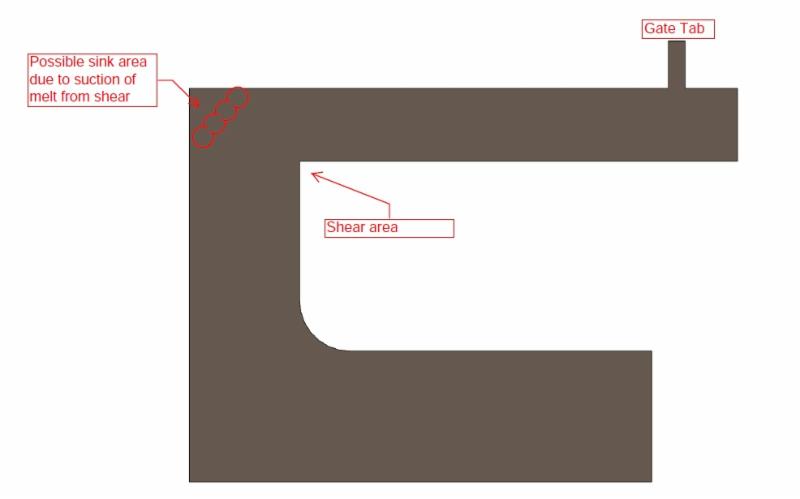|
Basics
Definition: unintended Indentations on the surface of a molded part.
Sink marks occur during the cooling process. Sinks tend to occur mainly on the thickest sections or where there is a change in wall thickness. If the thermal contraction (shrinkage) of the plastic cannot be compensated in certain areas, or the outside walls of the molded part are not stable enough, due to insufficient cooling, the outer layer is drawn inside by cooling stresses as shown in figure below.

Sinks occur in thicker section, junction of ribs, bosses, and sometimes in areas opposite high shear locations within a part.
There are basically three fundamental cases:
Solidification too slow - too hot of mold or material
Effective holding pressure time too short - thin to thick, timer is low
Not enough holding pressure transfer, because flow resistances in the mold are too high - thin to thick, mold possibly too cold for material processing
Fundamentally, the plastic is injected into the cavity, the outer wall solidifies and starts to cool, this cooling builds thickness, yet thicker section remain molten and upon cooling further cause the internal forces to suck in the walls, basically because the forces inside are greater than those outside. In some cases one may eject a part that is perfect but as the part sits outside the mold the internal heat radiates out to soften the external wall, at which point the stiffness of the wall declines and the forces inside cause the part to sink.
Example 2

Above shows the outer wall solidified and the forces which are applied to the thicker section drawing the part in causing the effect of shrinkage and resulting in sink on the surface of the thicker section. Note had the gate been in the thicker section than the issue may have been avoided.
The packing and subsequent holding pressure must supply, and maintain the material flow and pressure unto the molten material so as to minimize shrinkage and thus possible sink issue. Be aware of the flow system and that a reduction in paths and or time to freeze may be the factor, meaning if a gate freezes off too soon, or the nozzle, or an area in the runner. As shown in the examples above the gate is located in a thin wall area, feeding into a thicker wall, thus the thin wall freezes first.
Another issue to be aware of is that if the wall is sufficiently solidified to prevent sinks there may well be voids within the part. Should the part be under stress in operation these voids may lead to the failure of your part.
Example 3

Example 3 shows a possible issue that has been experienced with high injection rates, that is that the shearing action within the part cavity causes a venturi effect and actually draws material out of an already filled area and ultimately leads to sink in this area. This effect and resulting sink stays there no matter how much time and or pressure is applied. The only way to fix is to slow down the injection speed from a processing point.
SLSILVEY
01022015.02
|